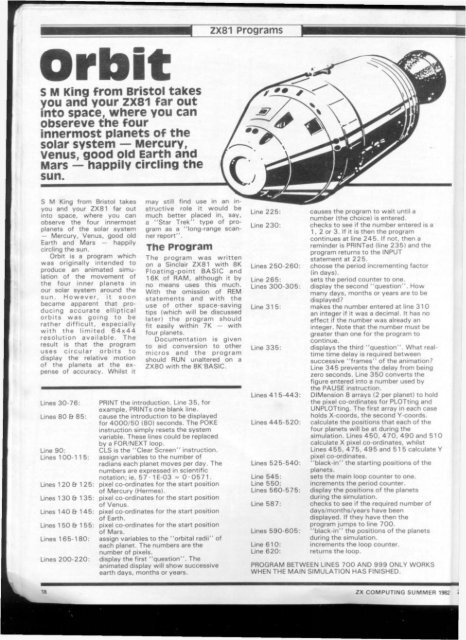ZX Computings - OpenLibra
ZX Computings - OpenLibra
ZX Computings - OpenLibra
You also want an ePaper? Increase the reach of your titles
YUMPU automatically turns print PDFs into web optimized ePapers that Google loves.
Orbit<br />
S M King from Bristol takes<br />
you and your <strong>ZX</strong>81 far out<br />
into space, where you can<br />
obsereve the four<br />
innermost planets of the<br />
solar system — Mercury,<br />
Venus, good old Earth and<br />
Mars — happily circling the<br />
sun.<br />
S M King from Bristol takes<br />
you and your <strong>ZX</strong>81 far out<br />
into space, where you can<br />
observe the four innermost<br />
planets of the solar system<br />
— Mercury, Venus, good old<br />
Earth and Mars — happily<br />
circling the sun.<br />
Orbit is a program which<br />
was originally intended to<br />
produce an animated simulation<br />
of the movement of<br />
the four inner planets in<br />
our solar system around the<br />
sun. However, it soon<br />
became apparent that producing<br />
accurate elliptical<br />
orbits was going to be<br />
rather difficult, especially<br />
with the limited 64x44<br />
resolution available. The<br />
result is that the program<br />
uses circular orbits to<br />
display the relative motion<br />
of the planets at the expense<br />
of accuracy. Whilst it<br />
Lines 30-76:<br />
Lines 80 & 85:<br />
Line 90:<br />
Lines 100-115:<br />
Lines 120Ef 125:<br />
Lines 130 & 135:<br />
Lines 140Ef 145:<br />
Lines 1 50 & 155:<br />
Lines 165-180:<br />
Lines 200-220:<br />
may still find use in an instructive<br />
role it would be<br />
much better placed in, say,<br />
a "Star Trek" type of program<br />
as a "long-range scanner<br />
report".<br />
The Program<br />
The program was written<br />
on a Sinclair <strong>ZX</strong>81 with 8K<br />
Floating-point BASIC and<br />
16K of RAM, although it by<br />
no means uses this much.<br />
With the omission of REM<br />
statements and with the<br />
use of other space-saving<br />
tips (which will be discussed<br />
later) the program should<br />
fit easily within 7K — with<br />
four planets.<br />
Documentation is given<br />
to aid conversion to other<br />
micros and the program<br />
should RUN unaltered on a<br />
<strong>ZX</strong>80 with the 8K BASIC.<br />
PRINT the introduction. Line 35, for<br />
example, PRINTs one blank line,<br />
cause the introduction to be displayed<br />
for 4000/50 (80) seconds. The POKE<br />
instruction simply resets the system<br />
variable. These lines could be replaced<br />
by a FOR/NEXT loop.<br />
CLS is the "Clear Screen" instruction,<br />
assign variables to the number of<br />
radians each planet moves per day. The<br />
numbers are expressed in scientific<br />
notation: ie, 57 • 1 E-03 - 0 • 0571.<br />
pixel co-ordinates for the start position<br />
of Mercury (Hermes),<br />
pixel co-ordinates for the start position<br />
of Venus.<br />
pixel co-ordinates for the start position<br />
of Earth.<br />
pixel co-ordinates for the start position<br />
of Mars.<br />
assign variables to the "orbital radii" of<br />
each planet. The numbers are the<br />
number of pixels,<br />
display the first "question". The<br />
animated display will show successive<br />
earth days, months or years.<br />
<strong>ZX</strong>81 Programs<br />
Line 225:<br />
Line 230:<br />
Lines 250-260:<br />
Line 265:<br />
Lines 300-305:<br />
Line 315:<br />
Line 335:<br />
Lines 41 5-443:<br />
Lines 445-520:<br />
Lines 525-540:<br />
Line 545:<br />
Line 550:<br />
Lines 560-575:<br />
Line 587:<br />
Lines 590-605:<br />
Line 610:<br />
Line 620:<br />
causes the program to wait until a<br />
number (the choice) is entered,<br />
checks to see if the number entered is a<br />
1, 2 or 3. If it is then the program<br />
continues at line 245. If not, then a<br />
reminder is PRtNTed (line 235) and the<br />
program returns to the INPUT<br />
statement at 225.<br />
choose the period incrementing factor<br />
(in days),<br />
sets the period counter to one.<br />
display the second "question". How<br />
many days, months or years are to be<br />
displayed?<br />
makes the number entered at line 310<br />
an integer if it was a decimal. It has no<br />
effect if the number was already an<br />
integer. Note that the number must be<br />
greater than one for the program to<br />
continue.<br />
displays the third "question". What realtime<br />
time delay is required between<br />
successive "frames" of the animation?<br />
Line 345 prevents the delay from being<br />
zero seconds. Line 350 converts the<br />
figure entered into a number used by<br />
the PAUSE instruction.<br />
DIMension 8 arrays (2 per planet) to hold<br />
the pixel co-ordinates for PLOTting and<br />
UNPLOTting. The first array in each case<br />
holds X-coords, the second Y-coords.<br />
calculate the positions that each of the<br />
four planets will be at during the<br />
simulation. Lines 450, 470, 490 and 510<br />
calculate X pixel co-ordinates, whilst<br />
Lines 455, 475, 495 and 515 calculate Y<br />
pixel co-ordinates.<br />
"black-in" the starting positions of the<br />
planets.<br />
sets the main loop counter to one.<br />
increments the period counter,<br />
display the positions of the planets<br />
during the simulation,<br />
checks to see if the required number of<br />
days/months/years have been<br />
displayed. If they have then the<br />
program jumps to line 700.<br />
"black-in" the positions of the planets<br />
during the simulation,<br />
increments the loop counter,<br />
returns the loop.<br />
PROGRAM BETWEEN LINES 700 AND 999 ONLY WORKS<br />
WHEN THE MAIN SIMULATION HAS FINISHED.<br />
18 <strong>ZX</strong> COMPUTING SUMMER 1982 i
















